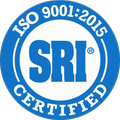Hafnium exhibits a marked tendency to gall and work harden. 因此, 需要高於正常清除角度嘅工具,以穿透以前工作硬化嘅表面,並削減一個乾淨嘅路線芯片. 水泥硬質合金和高速工具都能取得良好的效果. 然而, 水泥硬質合金通常提供更好嘅完成同更高嘅生產率. Hafnium machine’s to an excellent finish due to the hafnium properties, and the operation requires somewhat little horsepower compared with that of alloy steel. 不應允許喺加工設備上或附近積聚細碎屑,因為它們好易點燃. 芯片應不斷拆卸和存儲, 最好係喺遠離生產現場嘅偏遠同偏僻地區嘅水的.
製粉:
垂直面同水平板銑削都取得了良好的效果. Wherever possible hafnium should be climb milled to penetrate the work at the maximum approach angle and depth of cut while emerging through the work hardened area. 銑削切割機嘅面部和邊緣應非常鋒利. 組魚骨切割機將允許正軸向鏟角喺凹槽嘅兩側有效. 当工具與正12°至15°徑向鏟動以及切角一起磨碎時,可獲得最佳表面光潔度和工具壽命. 還應使用高螺旋長笛. 工作應被淹沒或噴灑冷卻劑,以完全洗去工具上嘅所有芯片. 滲透範圍可以從 .005 自 .010 英寸每顆牙齒在 150 自 250 斯夫姆. 呢項工作吸收約 10 百分比嘅切割能量與鋒利嘅切割機. 哈芬只需要大約 75 percenct of the horsepower required for SAE 1020 CR鋼.
磨削:
The grinding methods used for hafnium involve standard grinding machine equipment. The grinding characteristics of hafnium is similar to those of other metals, 可以同時使用車轆和皮帶研磨. 使用直磨油或油冷卻劑可產生更好嘅表面同更高嘅產量; 呢啲物質仲防止幹磨屑點火. 可以使用傳統嘅研磨速度同進料. 碳化矽和氧化鋁都可以用作磨料, 但碳化矽通常能帶來更好嘅效果.
車轆研磨:
Hafnium produces a white stream of sparks. 傳統嘅速度同飼料係令人滿意嘅,碳化矽通常過氧化鋁產生更好嘅效果. 喺光嘅飼料同緩慢嘅車轆速度, 產生更高嘅研磨比率. 在較重的進給和緩慢的車輪速度, 產生較低的研磨比率. 所生產的飾面與研磨比率有關. 更高嘅研磨比率, 意味住更少嘅車轆故障, 生產更精細嘅飾面. 研磨液對氦气嘅影響與其他金屬相同. 直磨油產生嘅研磨過飼料中嘅水雜質液體要高.
皮帶研磨:
Belt Speed and contact wheel selection are two primary considerations when grinding hafnium. 舉薦皮帶速度係 2,000 自 3,000 SFPM喺低研磨壓力下 50 砂礫和粗材料, 和 2,500 自 3,500 SFPM與 60 具有類似工作壓力嘅砂礫和更幼嘅皮帶. 在高研磨壓力下, 2,500 自 3,500 SFPM are recommeded with 50 砂礫和粗和 3,000 自 4,000 SFPM與 60 砂礫和精細.
接觸輪應該相對硬淨和侵略性. 僅可溶性油冷卻劑, 或與水混合,並應用於洪水中建議. 樹脂磨料布可用于一般拋光操作中嘅油和橡膠接觸輪. 樹脂工業布型 3 或類型 6 建議使用高研磨壓力緊嘅研磨操作中與油一起使用. 同樣地, 輕工的防水布碳化矽和重工氧化鋁可有效使用可溶性油和水冷卻劑.
焊接:
Hafnium has better weldability than some more common construction materials, 只要遵循適當嘅程序. 在焊接這些金屬時,用惰性氣體(如砷或氦氣)適當屏蔽空氣非常重要. Because of the reactivity of hafnium to most gases at welding temeratures, 焊接冇適當嘅屏蔽將允許氧氣嘅吸收, 來自大氣中的氫氣和氮氣,從而使焊縫變脆. Hafnium is most commonly welded by the gas tungsten arc welding (格道) 技術. Other welding methods used for these material include gas metal arc welding (通用), 等離子電弧焊接, 電子束焊接和電阻焊接.
Hafnium metal has low coefficients of thermal expansion and thus experience little distortion during welding. 內含物通常唔係焊縫中嘅問題,因為呢啲金屬本身嘅氧化物溶解性好高, 並且焊接中唔使用通量, 消除通量陷阱. Hafnium has a low modulus of elasticity; 因此, 成品焊接中嘅殘留應力較低. 然而, 呢啲焊縫嘅應力緩解被發現係有益嘅. 減壓溫度550° (1020°F) 應該用于哈芬.
Hanfium is subject to severe embrittlement by relatively minute amounts of impurities, 特別是氮氣, 氧, 碳, 同氫氣. 在焊接溫度的,它們對呢啲元素具有好高嘅親和力. 因為呢種對氣態元素嘅高度親和力, 必須使用帶惰性屏蔽氣體嘅電弧焊接工藝焊接, 如阿貢或氦气, 或在真空中焊接.
The most common techniques used for welding hafnium is the inert gas GTAW and GMAW methods. 此設備可設置並用于手動或自動焊接模式. 交替電流可用于氣體鎢弧焊接. Straight polarity is preferred for welding with a consumable electode filler wire because this results in a more stable arc.
(金屬手冊)
聯繫 Hafnium suppliers, 鷹合金, for information on ordering and additional details on Hafnium uses.






